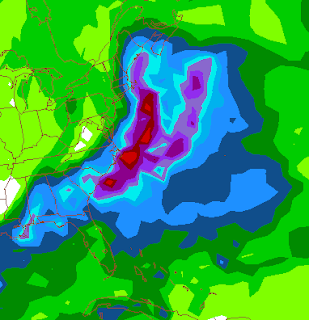January 87 was on of the "analog" winters I cited last year for my winter forecast(Winter 09-10) and it actually worked well. Most of the snow that winter was centered around the time period of Jan 22 until Feb 22 for our region. Jan 22 and Jan 25-26 had back to back snows of close to a foot over most of central and southwest Virginia.
I'm not sure how the event was forecast down here because at the time I was living in Delaware. Up there, they played catch up all day. Initially, we had a Winter Storm watch-- but the forecast called for 1-2 inches with a change to rain. By my bedtime, we had been upgraded to WARNING with 4 inches expected and then a change to sleet and rain. The next morning, the ante was upped right before the storm started to 6-8 inches with a possible mix and once the storm started that was upped to 8-10 inches. About the time we hit the 8 inch mark, they upped us to foot. Schools were not cancelled and snow begin to fall shortly before my bus arrived. We basically sat in first period while they decided what to do with us and by 10 am we were on the bus home. Took us a couple hours to get home ( I lived 3 miles from my school and had the LAST stop of the day) In Delaware we had a couple sleet pellets late, but nothing to hold down accumulations. Both Lynchburg and New Castle, DE had about 12.5 inches from this event.
Lynchburg had 3 hours of VERY heavy snow where 5 inches fell in that time frame--- Here is the total snowfall map AND the hour obs for the day here locally. Most places had between 12-15 inches because it was a fast mover. Click the second map to increase size--I've highlighted the hours where snow was heaviest and 5 inches fell in three hours.
About Next Week--
I'm still tracking an event for the the 25 and 26 of next week (To celebrate our second of the Twin Storms of 87??) There are three major models that extend that far, one is the GFS-- an american model, The second is the GGEM, from Canada and third is the ECMWF, from Europe.
The Breakdown-
Both the GGEM and the ECMWF dive some energy from the PAC NW of Canada, dump a little over the SW and bring it all out to create a storm in the Gulf of Mexico. Same issues sit as yesterday where the cold high is retreating but the low chugs JUST far enough east in todays data to provide a mainly snow episode compared to yesterdays snow to rain and back to snow scenario.
The GFS doesn't dig that energy as far SW befor ejecting it and we get a Miller B system ( Miller A- Storm out of the Gulf of Mexico, Miller B has a secondary development of the East coast. Historically, most of big snows are Miller A's. We get the all snow, maybe 2-3 inches in the GFS scenario. While this is an option I'm not willing to pull off the table, I don't see as the most likely outcome. Even the short term model called the NAM that goes out to 84 hours shows a much different synoptic set up compared to the GFS. In the end, someone's going to be wrong, and at this time I believe it will be the GFS. The GFS ensembles ( The model run multiple times to weed out bias issues) also "hedge" that this is not the most likely set up.
What's Next
Once we establish the general track, we begin to focus on the fine details of the temperatures and exact track to see if and when what area's turn to ice/rain. Because the existing cold air mass is rather strong, ice is a much bigger threat than normal. While I much prefer to have a forecast nailed down, this could come down to "nowcasting"-- checking radar and obs. In preparation, add me as a friend on Facebook (Ketih D. Huffman) or make a twitter account Lynchburgwx.








